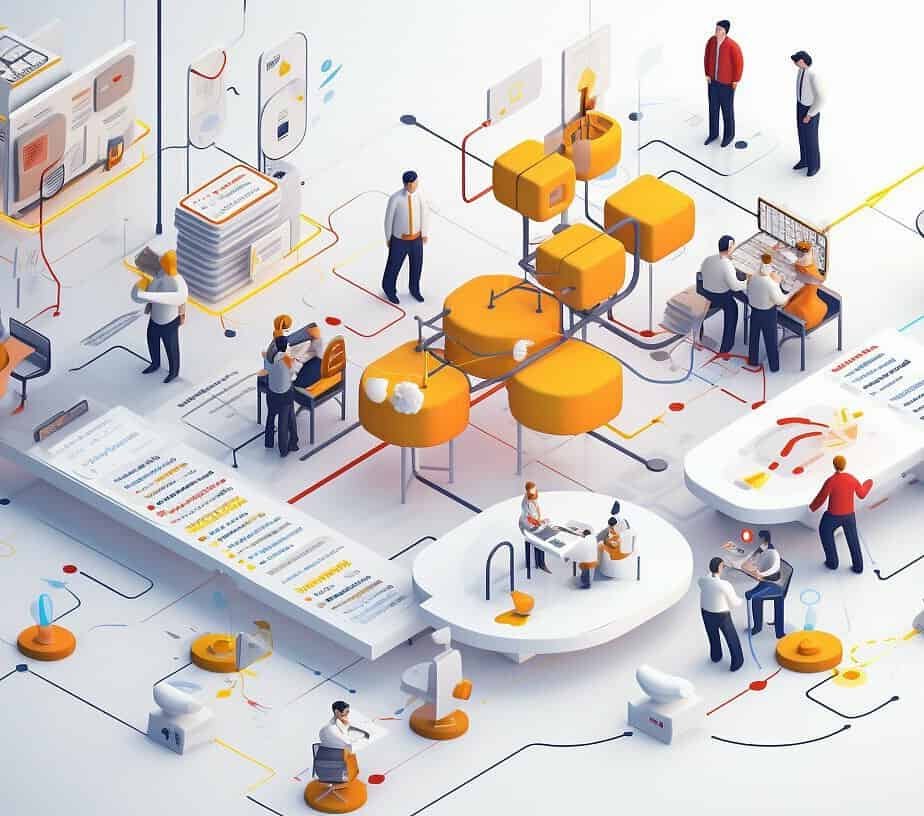Welcome to the world of No Code Education Technology (EdTech), where learning has become accessible and inclusive. No code education technology refers to education technology without coding, allowing anyone to learn and develop without the need for programming knowledge. This revolutionary approach to learning is changing the way we acquire knowledge and skills. In this section, we will introduce the concept of No Code Education Technology (EdTech) and discuss the benefits and platforms available to those who wish to learn without coding.
With No Code Education Technology (EdTech), you can learn to create applications without investing time in learning complex programming languages. No Code Education Technology (EdTech) platforms and tools offer a diverse range of features and functionalities, and are designed to accommodate learners of all levels, from beginners to experts.
The Rise of No Code Development
Traditionally, developing applications and software required extensive knowledge of coding languages, making it inaccessible to many people. However, with the rise of No Code development tools, anyone can create applications without the need for coding knowledge or experience.
No Code development has become increasingly popular in recent years, with a variety of platforms and tools available to users. These platforms provide a visual interface that allows users to drag and drop elements to create applications quickly and easily.
One of the most significant benefits of No Code development is the ability to create applications rapidly. Businesses can create applications to streamline processes quickly, and entrepreneurs can test and launch new ideas without the need for extensive coding knowledge.
There are several No Code platforms available, including Bubble, Webflow, and AppSheet, each with its unique features and capabilities. These platforms allow users to create a wide range of applications, including mobile apps, websites, and even chatbots.
No Code development has revolutionized the software development industry, providing accessibility and inclusivity for anyone interested in creating applications. With an increasing number of platforms and tools available, No Code development is becoming an essential aspect of the tech industry and is expected to continue to grow in popularity in the years to come.
The Benefits of Learning Without Coding
Learning without coding has several benefits that are making it an attractive option for individuals and businesses alike.
Accessibility and Inclusivity: No Code programming allows individuals who may not have a background in coding or a traditional computer science education to create their own applications. This makes programming more accessible and inclusive by removing barriers to entry, such as time and financial resources.
Increased Efficiency: No Code tools facilitate the creation of applications by automating many of the manual coding tasks typically required when developing software. This reduces the time and resources required to create custom applications, resulting in increased efficiency.
Wider Applications: No Code programming can be used across various industries and professions, from healthcare to finance and beyond. Its versatility makes it an attractive option for businesses seeking to streamline processes and improve operations.
Lower Costs: By removing the need for manual coding, businesses can save costs associated with hiring additional IT personnel or outsourcing their software development needs. This makes No Code programming an economical solution for small businesses and startups looking to create custom software.
No Code programming is changing the game for individuals and businesses, making programming more accessible, efficient, and cost-effective. Its versatility and ease of use make it a valuable tool for various industries and professions.
No Code Education Technology in the Classroom
No Code Education Technology (EdTech) is not just changing the way students learn, it’s also changing the way teachers teach. By leveraging the power of No Code platforms and tools, teachers can create engaging and interactive learning experiences that cater to diverse learning styles.
One example of No Code EdTech being used in the classroom is the platform Scratch. Scratch is a visual programming language that allows students to create their own interactive stories, games, and animations. With Scratch, students can learn programming concepts without having to write any code.
Another popular No Code platform used in education is Appy Pie. Appy Pie allows teachers and students to create mobile apps without any coding knowledge. This platform can be used to create educational apps that complement classroom learning and provide new ways for students to engage with course material.
In addition to No Code platforms, there are also a variety of No Code tools that can be used in the classroom. For example, Canva is a graphic design tool that can be used to create visual aids and presentations. Similarly, Wix can be used to create websites for class projects.
Overall, No Code Education Technology is transforming the way educators approach teaching and learning. With the help of these innovative platforms and tools, students can experience a more engaging and interactive learning experience.
No Code Software for Business
No Code software is not just for individuals looking to create their own applications; it can also benefit businesses. By utilizing No Code tools, businesses can streamline their processes and reduce costs. Customized software solutions can be created in a fraction of the time it would take with traditional coding, allowing businesses to stay agile and responsive to changing market needs.
There are a variety of No Code tools available for businesses, each offering its unique set of features and capabilities. Some tools, like Airtable and Bubble, enable users to create powerful and complex applications without writing a single line of code. Other tools, like Zapier and IFTTT, allow businesses to automate their workflows and integrate multiple applications together seamlessly.
No Code software is particularly valuable for small businesses and startups, which may not have the resources to hire in-house developers. With No Code platforms, business owners and non-technical team members can create solutions themselves, reducing the need for expensive contractors or outsourcing.
No Code Development for Business Automation
One of the primary benefits of No Code software for businesses is automation. By automating repetitive tasks and processes, businesses can improve efficiency and free up time for more important tasks. No Code tools like Zapier andIFTTT can be used to connect different applications and automate workflows, while other tools like Webflow and Bubble can be used to create custom automation solutions for a wide variety of business needs.
In addition to automation, No Code software can also be used for data analysis, customer management, and workflow optimization. Many No Code tools include built-in analytics and reporting features, making it easy for businesses to track their performance and optimize their strategies for success.
No Code Development for Entrepreneurs
No Code development has paved the way for entrepreneurs to turn their ideas into reality without having to rely on coding knowledge. This has made it possible for anyone with a creative vision to easily bring their business ideas to life.
The beauty of No Code development platforms lies in their user-friendliness, making them an ideal choice for entrepreneurs with limited technical skills. They offer a wide range of functionalities to create web and mobile applications, automate processes, and streamline workflows.
Tools for Entrepreneurs
There are several No Code platforms that are ideal for entrepreneurs, including Bubble, Webflow, and Glide. Bubble is popular for its drag-and-drop interface which allows users to easily create dynamic web applications. Webflow is another No Code platform that offers a range of design tools and templates to create responsive websites. Glide is a No Code platform that enables users to create mobile apps that can be launched instantly.
The availability of these No Code platforms has drastically reduced the cost of creating and launching applications, making it possible for entrepreneurs to turn their ideas into a viable business with minimal cost and effort.
No Code Development for Rapid Prototyping
No Code development is ideal for rapid prototyping, allowing entrepreneurs to test and validate their ideas in a matter of hours or days instead of months. With No Code platforms, entrepreneurs can easily create a minimum viable product (MVP) and share it with potential customers for feedback and validation. This reduces the risk of investing time and resources in an idea that may not have a market fit.
In conclusion, No Code development has made it possible for entrepreneurs to turn their ideas into reality without the need for coding knowledge. It offers a range of functionalities and platforms that allow for rapid prototyping and cost-effective application development.
No Code Development: Learning Without Coding
Learning No Code development has never been easier, with an increasing number of resources available online. Whether you’re looking to create a new app or streamline your business processes, No Code development can provide a cost-effective and efficient solution. Here are some tips and resources to get started:
- Choose the right learning platform: There are a variety of No Code platforms and tools available, each with their own strengths and weaknesses. Research and compare different options to find the best fit for your goals and needs.
- Take online courses: Many online learning platforms offer No Code development courses, ranging from beginner to advanced levels. Look for courses that offer hands-on experience and practical projects to gain a deeper understanding of the tools and platforms.
- Join online communities: No Code development communities such as forums, Facebook groups, and Slack channels can provide valuable insights and support. You can ask questions, share your projects, and connect with other No Code developers.
- Attend events and workshops: Many No Code development events and workshops are available in major cities. These can provide a more immersive learning experience and the opportunity to network with other developers and experts.
Learning No Code development can be a fun and rewarding experience. With the resources and tools available, anyone can create and deploy their own app or software solution without writing a single line of code.
No Code Development and Digital Transformation
No Code development is revolutionizing the way businesses operate by promoting digital transformation. This involves the integration of digital technology into all areas of a business, resulting in fundamental changes to how businesses operate and deliver value to customers. No Code development is an essential tool for digital transformation because it allows businesses to quickly and easily create customized software solutions without relying on a team of developers or coding expertise.
One of the key benefits of No Code development in digital transformation is its speed. Businesses can quickly create and test new software solutions, allowing them to stay ahead of their competition and respond to changing market conditions with agility. This also allows businesses to reduce costs by eliminating the need for large development teams and the associated overhead costs.
There are several No Code platforms that businesses are using to drive digital transformation, including Bubble, Airtable, and AppSheet. These platforms allow businesses to build custom applications for their specific needs and integrate them with other software platforms, such as Salesforce and Shopify.
By leveraging No Code development and promoting digital transformation, businesses can improve their operations and deliver value to their customers more efficiently and effectively. As No Code development continues to evolve and advance, we can expect to see even greater transformation in the business world.
No Code Development and Automation
No Code development is not just about creating simple applications. It is also about automation and improving efficiency. By using No Code tools, developers can create workflows and automate processes that would otherwise require manual intervention. This allows businesses to save time and resources, and focus on core activities that drive business growth.
There are many No Code tools available for automation purposes, ranging from simple workflow builders to complex automation platforms. Some popular options include Zapier, IFTTT, and Workato. These platforms allow developers to connect different applications and automate tasks like data entry, file management, and email notifications.
| No Code Tool | Description |
|---|---|
| Zapier | Connects different applications and automates tasks using pre-built workflows called Zaps. |
| IFTTT | Allows users to create custom Applets that trigger actions across multiple applications. |
| Workato | Offers a range of automation tools including API connectors, workflow management, and data integration. |
No Code automation is not just about creating simple tasks. It can also be used for complex processes like inventory management, customer relationship management (CRM), and financial reporting.
By using No Code development for automation, businesses can free up resources and focus on high-value tasks. It can also result in cost savings, increased accuracy, and improved productivity. As technology continues to evolve, the possibilities for No Code automation are endless.
The Future of No Code Education Technology
No Code Education Technology (EdTech) has already revolutionized the way we learn, making education more accessible and inclusive. The future of No Code EdTech is even more exciting, with continued advancements in technology and the proliferation of No Code platforms and tools.
The Evolution and Advancement of No Code Development
No Code development will continue to evolve and advance, with the development of new platforms and tools that make it even easier to create complex applications without coding. As the benefits of No Code development become more widely recognized and accepted, we can expect to see an even greater proliferation of No Code tools and platforms in the years to come.
The Impact of No Code EdTech on the Workplace
No Code EdTech is already having a significant impact on the workplace, enabling businesses to streamline processes and reduce costs through the use of customized software solutions. In the future, we can expect to see even greater adoption of No Code development in the workplace, with businesses using No Code tools and platforms to automate processes and improve efficiency.
The Future of Education with No Code EdTech
The future of education with No Code EdTech is bright, with educators using No Code tools and platforms to create engaging, interactive learning experiences for students. No Code EdTech will continue to promote accessibility and inclusivity in education, with more students able to access quality education regardless of their background or circumstances.
The Role of No Code EdTech in Digital Transformation
No Code EdTech will play a crucial role in digital transformation efforts, enabling businesses to embrace new technologies and operate more efficiently. With the help of No Code tools and platforms, businesses will be able to automate processes, reduce costs, and stay competitive in an increasingly digital world.
The Importance of Learning No Code Development
Learning No Code development will become increasingly important in the years to come, as businesses and individuals seek to take advantage of the many benefits of No Code platforms and tools. There are many resources available for learning No Code development, including online courses, tutorials, and communities where learners can connect and collaborate.
Conclusion
The future of No Code EdTech is exciting and filled with possibilities. With continued advancements in technology and the proliferation of No Code platforms and tools, we can expect to see significant growth in the adoption of No Code development in the years to come.
Success Stories in No Code Development
No Code development has enabled individuals and businesses to achieve incredible success, even without prior coding knowledge. Here are some inspiring success stories:
| Name | Background | Success Story |
|---|---|---|
| Annie Sullivan | Marketing Manager | Annie used No Code tools to create a personalized CRM for her team, increasing sales and improving productivity. She went on to become a No Code consultant, helping other businesses streamline their processes. |
| Joe Ramirez | Entrepreneur | Joe used No Code platforms to quickly build and launch his startup idea, a web-based project management tool. His company grew rapidly and was acquired by a larger software company for a substantial amount. |
| Alexa Rodriguez | Non-profit Manager | Alexa used No Code tools to create an online database for her organization, making it easier to track and report data. Her efforts helped secure more funding for the non-profit, allowing them to expand their services to more communities. |
These success stories demonstrate the power of No Code development and the possibilities it offers to individuals and businesses alike. With the right tools and resources, anyone can learn No Code development and achieve their goals.
No Code Development: Frequently Asked Questions
As No Code Development continues to gain popularity, many people have questions about how it works and what it can do. Here are some frequently asked questions about No Code EdTech, No Code Learning, and No Code Development.
What is No Code Development?
No Code Development is a way to create software applications without writing code. Instead, users can use visual interfaces and pre-built components to create their applications.
Why is No Code Development becoming so popular?
No Code Development is becoming popular because it allows people without technical backgrounds to create applications. It also allows developers to create applications faster and with less code.
What are some examples of No Code Development platforms?
There are many No Code Development platforms available, including Bubble, Webflow, and AppGyver.
What are the benefits of learning No Code Development?
Learning No Code Development allows individuals to create their own applications without needing to hire a developer. It also allows businesses to create customized software solutions more quickly and at a lower cost.
Is No Code Development suitable for enterprise-level applications?
Yes, No Code Development is suitable for enterprise-level applications. Many businesses are using No Code Development to create customized software solutions.
What are some tips for learning No Code Development?
Some tips for learning No Code Development include taking online courses, attending workshops, and practicing with different No Code Development platforms.
Is No Code Development the future of software development?
No Code Development is becoming increasingly popular, but it is not likely to replace traditional software development entirely. Instead, it will likely become one of many tools used by developers.
Where can I find more information about No Code Development?
There are many resources available for learning more about No Code Development, including online courses, forums, and conferences. Some popular websites for No Code Development include NoCode.tech and Makerpad.




0 Comments